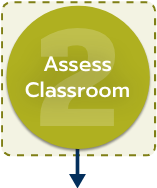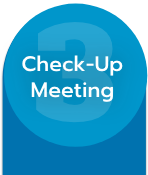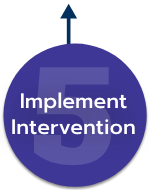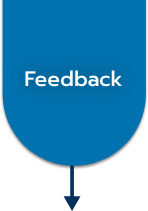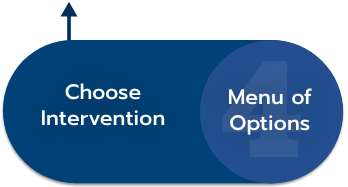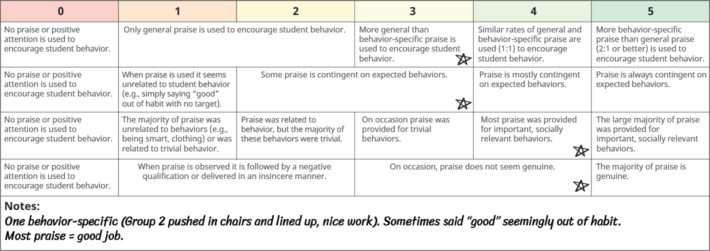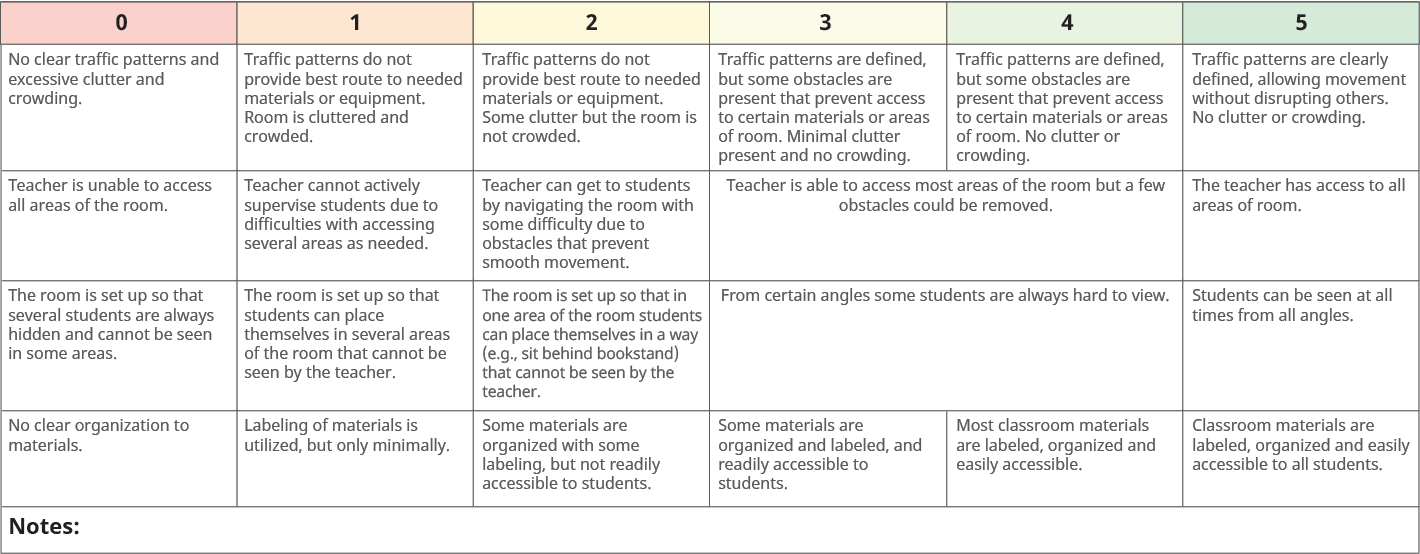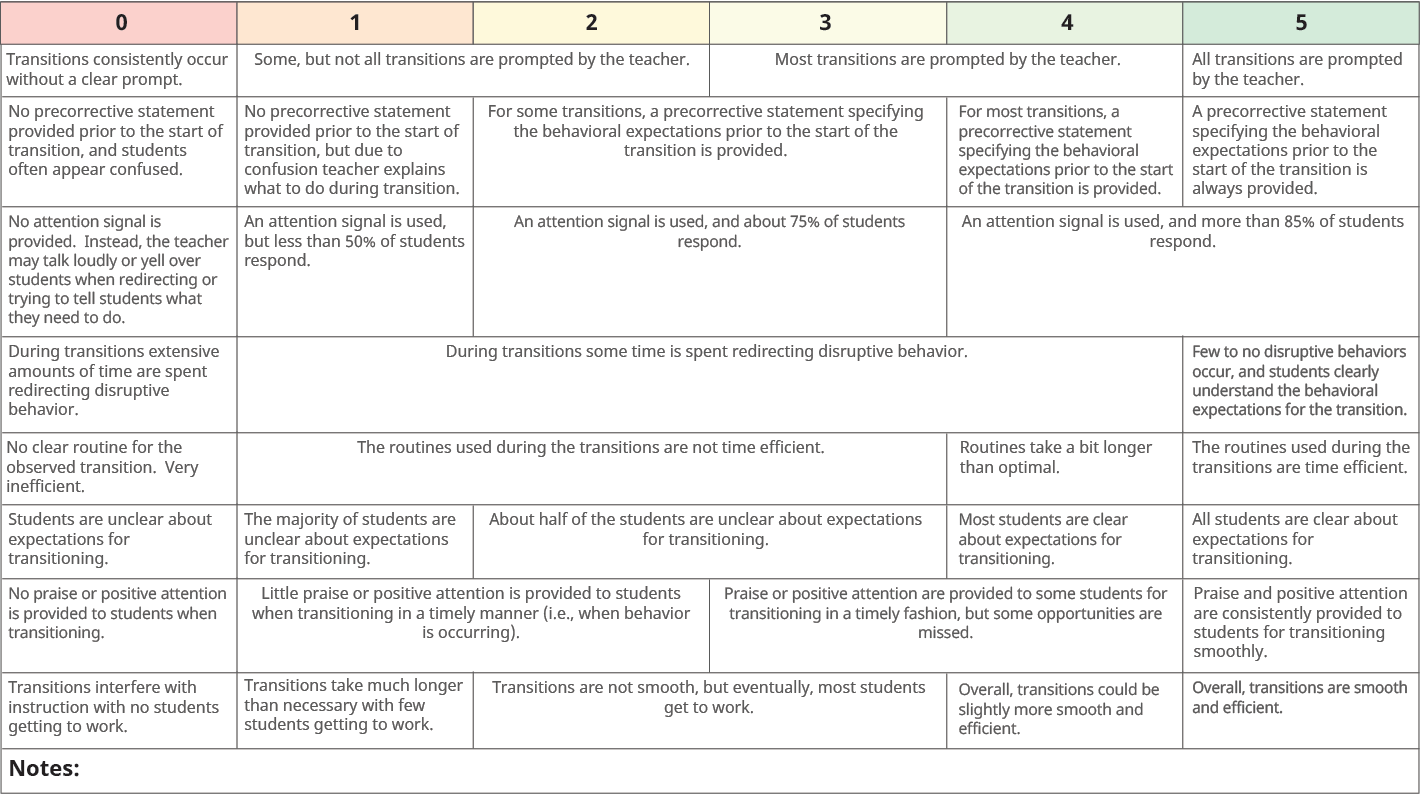Procedure: Assess Classroom
Coaching Process > Assess Classroom
You will use all of the information you gather about the classroom to provide the teacher with personalized feedback during the Check-Up meeting.
There are five elements to gathering accurate and useful classroom information:
How To
You will conduct several classroom observations to assess several domains of important classroom management. Plan to observe in the classroom for a minimum of 30 minutes (or more) on at least two occasions. Three observations are ideal. Arrange to conduct observations during times the teacher reports to be the most challenging times of the day. If possible, arrange the observation so that you will be able to observe academic instruction, as well as transitions between subjects.
The following domains of classroom management will be targeted for observation, because research indicates that using effective classroom management strategies in these domains will reduce disruptive behavior and increase student success:
Concrete objective information within each of these domains can be gathered during a classroom observation visit. Using the CCU Classroom Assessment Rubric, you will score each item to determine if it is an area of concern that needs attention or an area of strength across the four classroom management domains. This information can be used to provide feedback to the teacher on the use of effective classroom management strategies.
The following breaks down each observation into setting up and beginning a classroom observation, gathering frequency data, scoring the CCU Feedback Survey, ending the observation, and combining information from multiple observations.
Setting Up & Beginning an Observation
Setting Up an Observation
Be sure to set up the observation time and day in advance with the teacher. You’ll want to observe during the most challenging times of the day to get a good sense of what is going well and what could be improved. You should plan on visiting the classroom for 30 minutes or more for each observation. During this time, you will want to see both academic instruction and transitions, if possible.
Describe to the teacher the purpose of the observation and what you will be looking for in the classroom.

The purpose of coming to observe in the classroom is to allow me to see how things are going in the classroom. I will be looking at how the students behave during instruction and during transitions, how the classroom is set up, and how you use praise and reprimands in your classroom. I will stay in the classroom for 30-40 minutes. After each observation, I will ask you if it was a typical day or not. When we feel I have seen several typical days, we will meet again and I will share the information I gathered with you. Then, we can decide on which new strategies you will want to try out in your classroom. Do you have any questions?
When I come to your classroom, I will be very discreet and not interact with you or the students. If you want to let the students know why I am visiting, we might tell them I am just here to see what they are learning in class. Sound OK?
Beginning an Observation
When you enter the classroom, discreetly let the teacher know you are there to observe. You may want to ask the teacher if the time still works for you to visit. Then, find an unobtrusive location in the classroom that allows you to view the teacher, students, and classroom setup.
Begin by scanning the classroom, making note of the physical layout of the room, noticing any areas of the room that are cluttered or where students may not be able to view the teacher. Look for posted classroom rules and a daily schedule and determine how materials are organized. If you need to walk around the room, do so quietly without interrupting normal activities in the classroom. Refrain (as much as possible) from getting into discussions with students.
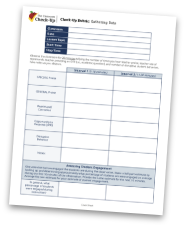
If you are good at multitasking, you may begin scoring the CCU Classroom Assessment Rubric. If not, wait until you have gathered 20 minutes of frequency data before scoring the rubric.
You may want to have a clipboard with you to hold the rubric as you score. Make notes as needed on the rubric form to allow for useful and accurate scores.
Gathering Frequency Data
You will gather frequency data on a number of teacher and student behaviors. The information will help guide which classroom management strategies will be most useful in a particular classroom.
Observing during a time when the teacher is providing students with instruction is best and will provide you with the most accurate and useful information. You will be looking for the following teacher and student behaviors:
Praise
- What is it?
- Teacher approval of desired student academic or social behaviors.
- Two types:
- General: praise statement that does not provide specific feedback (e.g., “Good job,” “Nice work”).
- Behavior specific: praise statement that tells the student the behavior for which they are being praised (e.g., “Thank you for raising your hand”).
- Why is it important?
- Praise reduces off-task and disruptive behaviors and increases instructional time.
- Behavior-specific praise makes teacher expectations clear, increases student motivation and sense of competence, and has the biggest benefits for reducing problem behaviors in the classroom.
Reprimands
- What is it?
- Teacher comments or gestures made by the teacher indicating disapproval of student behavior.
- Why is it important?
- Sets the emotional tone and climate of a classroom.
Ratio of Interactions
- What is it?
- The number of positive to negative interactions in a classroom.
- Usually calculated as the number of total praise statements to reprimands in a given period of time.
- Why is it important?
- Higher rates of positive to negative interactions lead to more positive teacher-student relationships, higher rates of student compliance, and fewer classroom disruptions.
- Well-functioning classrooms have positive to negative ratios of 3:1 or better.
Opportunities to Respond (OTR)
- What is it?
- Any time a teacher requests students to answer an academic question.
- Why is it important?
- Increasing the rates of opportunities for responding during instruction generates more learning, provides important feedback to the teacher, and increases on-task behavior.
- Goal: 4-6 per minute for new material; 9-12 per minute for drill and practice.
Student Disruptions
- What is it?
- Statements or actions of an individual student or group of students that interfere with ongoing classroom activities.
- Why is it important?
- Disruptions interfere with instruction and cause stress for teachers and students.
- Tracking disruptions is a good tool for monitoring whether classroom management strategies are working.
Classwide Student Engagement
- What is it?
- A snapshot of what percentage of students are on-task during a given period of time.
- Why is it important?
- Student engagement provides an indication of student interest in instructional content and activities.
- Low student engagement can be addressed through changes in instructional pacing and design.

After gathering frequency data during the 20-minute observation, score the rubric using the information you gathered to inform your scores.
You will want to review the CCU Classroom Assessment Rubric in advance of beginning an observation. Become familiar with the layout and how each classroom management domain operationalizes the subsequent areas within each domain. The rubric is set up so that higher scores are better.
Areas receiving a “5” have all indicators in place and demonstrate an area of strength (green zone) in classroom management. Areas receiving a “3” have some indicators missing or not in place, demonstrating that this an area that could use improvement (yellow zone). Areas receiving a “0” have little to no indicators in place and are areas in need of attention (red zone).
Following scoring each indicator within the area, determine the best overall score for that area. For instance, the best overall score for use of praise in the example above would be a “3” or in the yellow as more of the indicators fell into this range. The indicators provide guidance to what you determine to be the best overall score for that observation. Notice for praise, that if no praise is provided, the observation earns a score of “0.”
Inputting the CCU Rubric Information into the Feedback Survey
After completing observations in the classroom and scoring the rubric based on these observations, it is time to input this data into the Feedback Survey. The Feedback Survey will go through each item on the CCU rubric. Use your scored rubric to enter the data. The statement you chose on the rubric will be the same statement you choose in the Feedback Survey.
Adding an Area to the Feedback Survey
On occasion, you may want to address an area of strength or weakness not indicated on the CCU rubric. You can add an “Other” category when completing the Feedback Survey. This will then populate on the teacher’s feedback form.
Once you complete the Feedback Survey, a feedback form for that teacher will populate and be ready for review (above on right). You will want to review the feedback form in advance of meeting with the teacher. As you review the feedback with your teacher, use examples from your observation to inform the discussion.
To review the feedback form, go to the My Teachers page and click on the Check-Up Feedback button for your teacher.
Classroom structure is a term that gives attention to the actual physical layout of a classroom, organization of materials in the classroom, and the extent to which classroom expectations and routines are explicitly defined and taught. Well-structured classrooms are predictable and organized.
You will score the classroom across four areas of classroom structure:
When observing in the classroom, consider how the physical layout and organization of the classroom may be optimized:
- It is optimal to physically arrange classrooms with minimal barriers and plenty of open clear traffic patterns so that students and teachers can easily move around the classroom without disturbing other students while they are working.
- A good physical layout allows teachers to actively supervise student behavior and academic progress on instructional activities.
- Classroom materials are labeled, organized, and easily accessible to all students.
When observing in the classroom, consider how the classroom rules may be optimized:
- Effective classroom rules are positively stated, specific, observable, and concise.
- Students display the expected behavior because the rules have been taught and reviewed as needed.
- Practicing the rules is helpful, particularly when large numbers of students are not displaying the expected behaviors.
- Teacher gives a lot of behavior-specific praise and positive attention to students for following the rules.
- Classroom rules are consistently enforced by the teacher.
 When observing in the classroom, consider how the classroom routines may be optimized:
When observing in the classroom, consider how the classroom routines may be optimized:
- Routines work best when the behavioral expectations for each routine are defined so that they are developmentally appropriate, culturally responsive, positively stated, specific, and observable.
- Students learn routines when they are explicitly taught and reviewed.
- The teacher provides positive attention to students when they effectively demonstrate the routines using praise or rewards.
- Having visual prompts of the classroom routines displayed is very useful, keeping each routine to the fewest steps possible.
When observing in the classroom, consider how classroom transitions may be optimized:
- Smooth transitions use efficient routines that quickly get students to the next task, losing little time for instruction.
- Teacher explicitly teaches students how to transition smoothly and provides practice as needed.
- Teacher uses effective attention signals which are taught to students to gain their attention before transitions begin.
- Teacher provides precorrections to tell students exactly what to do prior to a transition occurring.
- Teacher provides behavior-specific praise to students as they transition smoothly to the next task.
Reflection & Tips:
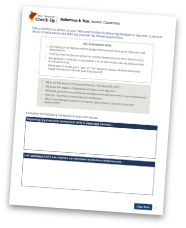
References to Other Relevant Resources:
Reinke, W., Herman, K., & Sprick, R. (2011). Motivational interviewing for effective classroom management: The classroom check-up. New York, NY: Guilford Press.
Sprick, R. (2009). CHAMPS: A proactive and positive approach to classroom management. Eugene, OR: Pacific Northwest Publishing.

